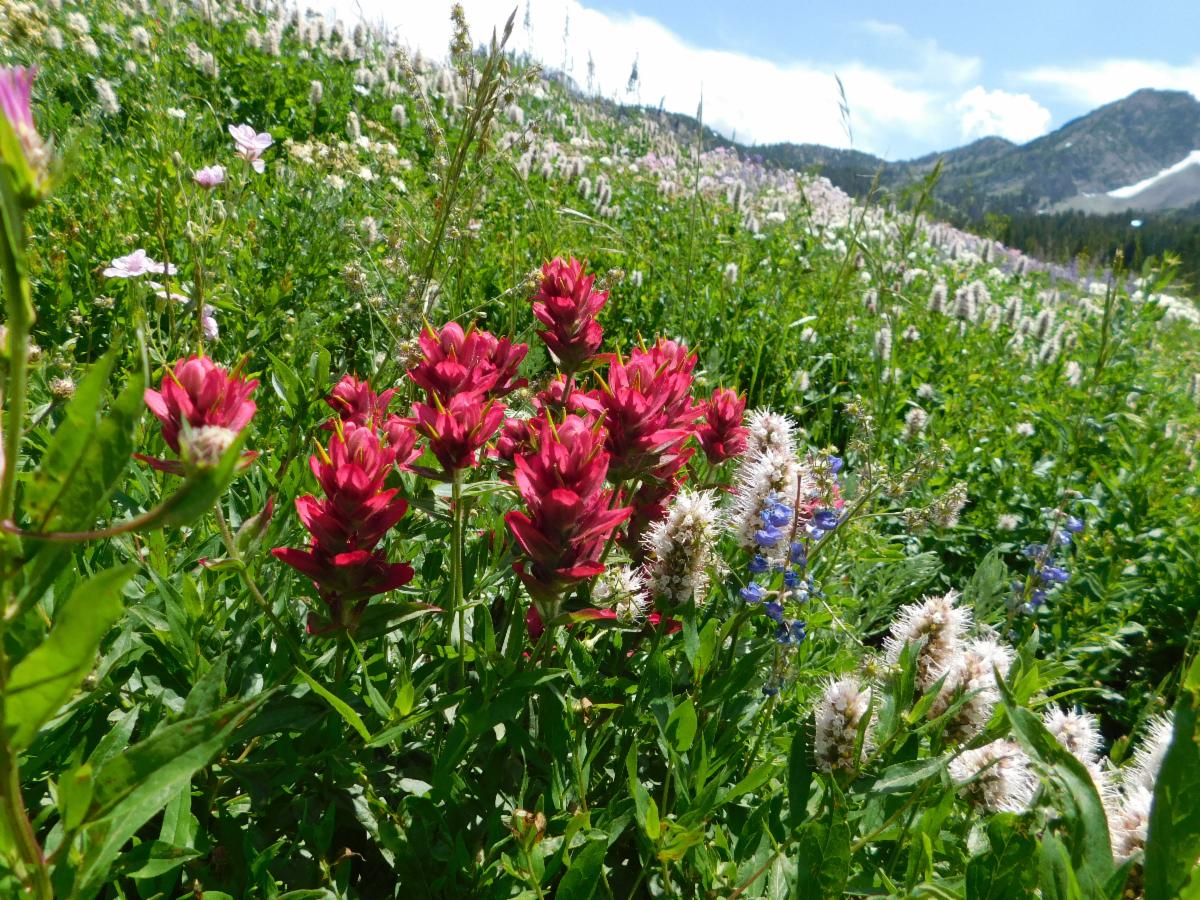Educational and Reference Resources of the Tri-Canyons
Ecology on the Trail: Biodiversity
Biodiversity
Welcome to Trails. Online. Ecology on the Trail!
 In this article we are going to focus on biodiversity!
In this article we are going to focus on biodiversity!
← Look for this Earth Icon to easily locate activities or bonus tips.
Teacher Supplements
Teacher Presentation
Student Guide
Map – Temple Quary Trail
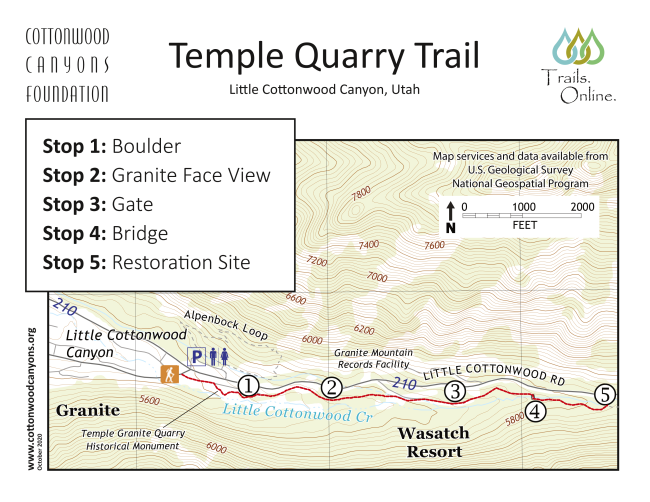
Trail: This adventure will be starting off on the Temple Quarry Trail, then continuing onto the Little Cottonwood Trail up to our Restoration Site.
Directions: There is a parking lot at the trailhead at the junction of UT-210 and UT-209. Overflow parking can be found on the north side of UT-210 at the Little Cottonwood Park and Ride, please use caution in crossing the canyon road. Restrooms are located at the Temple Quarry trailhead and at the Little Cottonwood Park and Ride.
Trail Information: The route is 1.4 miles one way. Start your hike by following the paved trail near the historic marker in the southwest corner of the parking lot. You’ll follow this trail for 0.2 miles until the end where it intersects with a dirt trail. Turn right/head east on the dirt trail. Once you hit a road, turn right. Veer left onto Granite Cliffs Road. At the next junction veer right towards the power plant and head for the gate to the left of the building. The gate will have a sign for the Little Cottonwood Trail.
Additional Trail: We will be ending the tour at the Restoration Site, though you can continue walking the Little Cottonwood Trail until you reach the Temple Quarry Ruins (an additional 2 miles one way). There is also a junction for the trail to Lisa Falls 1.5 miles beyond the Restoration Site.
Pre-Activity – Biodiversity
 What is biodiversity? Sometimes it is helpful to break words down into parts. “Bio” means life, and “diversity” means many different kinds. So biodiversity refers to the many different kinds of life on Earth, including plants, animals, fungi, and even microorganisms! Biodiversity also includes the variety of habitats and ecosystems that cover the planet.
What is biodiversity? Sometimes it is helpful to break words down into parts. “Bio” means life, and “diversity” means many different kinds. So biodiversity refers to the many different kinds of life on Earth, including plants, animals, fungi, and even microorganisms! Biodiversity also includes the variety of habitats and ecosystems that cover the planet.
Why is biodiversity important? A biodiverse world supports many species of plants, animals, and ecosystems that all benefit us in many ways! We rely on healthy ecosystems to produce oxygen and food, clean our water, provide medicines, and supply raw materials like timber and fiber. We also need biodiversity to protect our water supply, prevent flooding, filter out pollution, recycle nutrients, maintain healthy soils, and help stabilize our climate. A biodiverse world also has social benefits, providing recreation and being an important part of culture and identity.
ACTIVITY – Biodiversity Study: For this activity you’ll need some paper, a writing utensil, and something you can use to create a large circle with. A hula hoop is great, but other items like a long string or even a phone charging cord will work just fine! The key is that we want something that will create a circle of a fixed size, so we can replicate our study area at a different location later. Once you have gathered your materials, head out into your yard, schoolyard, or a park. Place your hula hoop (or other item) on the ground somewhere. This will be your study area. First, take an inventory of all the plants within your circle. It is okay if you don’t know the names of each plant, you can describe them the best you can! Now count how many you see of each type of plant. Next, focus on insects or any other creatures within your circle. Does your data tell you anything about this location? Is there more biodiversity here than you thought before you started? Hold onto your data, because we’ll do this activity again later.
Stop One – Boulder
Topic: Geology
 The name Temple Quarry comes from the fact that the rock here was quarried to build the Salt Lake Temple. Work began here in 1861 and continued until 1893. The workers would split the boulders using rock drills, iron bars, and wedges. Though boulders were split into smaller sizes, some of them weighed up to 3 tons! For reference, one ton is equal to 2,000 pounds! Can you imagine trying to move a boulder that heavy? These pieces then needed to be transported 20 miles to the Temple. At first, this was done using oxen and carts and the trip took between 3 and 5 days! Later, after the railroad was built, boulders and rocks could be transported via rail. Once on-site, stonecutters would shape the pieces to use for construction. Aside from the Temple, rock from this location was also used to construct the Utah State Capitol and the LDS Conference Center.
The name Temple Quarry comes from the fact that the rock here was quarried to build the Salt Lake Temple. Work began here in 1861 and continued until 1893. The workers would split the boulders using rock drills, iron bars, and wedges. Though boulders were split into smaller sizes, some of them weighed up to 3 tons! For reference, one ton is equal to 2,000 pounds! Can you imagine trying to move a boulder that heavy? These pieces then needed to be transported 20 miles to the Temple. At first, this was done using oxen and carts and the trip took between 3 and 5 days! Later, after the railroad was built, boulders and rocks could be transported via rail. Once on-site, stonecutters would shape the pieces to use for construction. Aside from the Temple, rock from this location was also used to construct the Utah State Capitol and the LDS Conference Center.
Photograph of workers quarrying stone in Little Cottonwood Canyon. Adapted from Set In Stone, Fixed in Glass – 3: Charles R. Savage, by Nelson B. Wadsworth for Signature Book Library, retrieved from http://signaturebookslibrary.org/set-in-stone-fixed-in-glass-3-charles-r-savage/
When we think about biodiversity, we can also look at the fossil record to learn about prehistoric biodiversity. A fossil is any preserved remains or traces of a once-living plant or animal. Fossils of marine invertebrates like corals, brachiopods, gastropods, and trilobites from the Paleozoic Era (541 – 485.4 million years ago) have been found here in the canyons. What does that tell us about the land here during that time? It indicates that this area, like much of North America, was covered by a shallow sea. Fossils of mammoth, musk ox, and other Ice Age mammals have been found around the mouth of Big Cottonwood Canyon, where there once was a shoreline of the Pleistocene Lake Bonneville. Do we have any mammals in Utah today that resemble a mammoth or a musk ox? (Answer: No). Look at the pictures of marine invertebrates below, and remember that an invertebrate is something that does not have a backbone. Are there creatures that you can find in the canyons today that resemble any of these? How about in other places in the world?
To learn more about fossils and how they are formed, check out this video from the Natural History Museum of London.
Bonus #2: How does geology contribute to biodiversity? Rock is literally the foundation for an ecosystem. Whether an area has exposed rock, or bedrock that is the parent material for the soil, the geology of a site determines which plants can grow there and which animals can live there. Amazing!
Stop Two – Cliff View
Topic: Wildlife
If you are lucky, you might catch a glimpse of a mountain goat up on the rocky mountainside! Mountain goats are not native to Utah, they were introduced into the Wasatch in 1967 and have been introduced to other locations within the state since then. Mountain goats were able to fill a niche that was previously unfilled by other large mammals, which gives them an advantage in terms of the plants that they eat. Their habitat consists of jagged cliffs and rocky mountainsides. The fact that they are able to live in these places keeps them protected from predators and free from competition from other large mammals like moose, elk, and mule deer that also eat plants but cannot climb rocky cliffs. Their habitats are found within alpine and subalpine ecosystems. Alpine ecosystems exist on mountains above the treeline, while subalpine ecosystems exist just at or below the treeline. Mountain goats have some adaptations to help them live in their habitat. What would you need if you lived on steep, rocky cliffs? One adaptation that enables a mountain goat to live in such a place is their hooves!  Their hooves are split down the center to help them balance and grip onto narrow ledges. The spongy pad on the bottom of their hoof gives them extra traction. They also have short, strong legs that help them jump and climb. How do they impact biodiversity? How do they affect the soil and plants in the ecosystem that they are a part of? Scientists in Utah are starting to ask these questions in order to understand how to manage populations of mountain goats.
Their hooves are split down the center to help them balance and grip onto narrow ledges. The spongy pad on the bottom of their hoof gives them extra traction. They also have short, strong legs that help them jump and climb. How do they impact biodiversity? How do they affect the soil and plants in the ecosystem that they are a part of? Scientists in Utah are starting to ask these questions in order to understand how to manage populations of mountain goats.
While predatory animals (those that eat other animals) tend to have a bad reputation, they are critical in maintaining healthy ecosystems and local biodiversity. To understand how this works, we have to remember the idea of an ecosystem as a whole and how all of the living and nonliving things are interacting and impacting one another. Can you think of some predators that live in the canyons? (Answers may include mountain lions, bobcats, coyotes, weasels, mink). What would happen if we didn’t have predators in the canyons at all? If we didn’t have any predators, there would be no way to control the population of prey animals. Prey animals eat plants, and if the population of prey animals (like hares and squirrels) grew out of control, what do you think would happen to the plants? We would see less and less of them. This can then cause other problems. When we talked about erosion, we mentioned how plant roots help stabilize the soil. Without plants, we would see more erosion from wind and from water. This can negatively impact our watershed and our drinking water. All of these things are connected!
Bonus: While you are hiking, record how many different types of animals you see. You may only see evidence of animals. Remember all the way back to week 1 where we talked about evidence including tracks, fur, feathers, scat, browse, etc.
Stop Three – Gate
Topic: Plants
One of the problems that the canyons face is the presence of invasive plants. Invasives are plants that have been introduced to an area where they are not naturally found. Sometimes this can happen by accident, or sometimes this can happen on purpose if people don’t know that what they are planting is harmful. They are a problem because they can reduce biodiversity. Invasive plants are great at growing, but they are not very good at sharing space and resources.  They can spread rapidly and can crowd out native plant species which can then impact the animals that rely on those plants for food. Some invasive plants can even change the soil to make it toxic, preventing native plants from being able to grow. How can you help stop the spread of invasive weeds? You can learn about what plants are invasive. Check your hiking boots, clothing, and gear for any seeds and dispose of them properly. Stay on designated trails while hiking. Don’t pick the wildflowers or other native plants. For a hands on experience, join us for a volunteer weed pull! These are typically hosted in the summertime.
They can spread rapidly and can crowd out native plant species which can then impact the animals that rely on those plants for food. Some invasive plants can even change the soil to make it toxic, preventing native plants from being able to grow. How can you help stop the spread of invasive weeds? You can learn about what plants are invasive. Check your hiking boots, clothing, and gear for any seeds and dispose of them properly. Stay on designated trails while hiking. Don’t pick the wildflowers or other native plants. For a hands on experience, join us for a volunteer weed pull! These are typically hosted in the summertime.
The plant you see here is called moneyplant. By looking at the seed pods, can you guess why they are called moneyplant? It is because they resemble coins! On your walk back to the parking lot, you’ll also pass by some Scotch thistle. These are just two of the many invasives that can be found in the canyon.
We have such an incredible variety of plant life in the canyon, but we wanted to feature one that is considered to be a living fossil. Keep an eye out along the trail for horsetail (also called snake grass or scouring rush). Relatives of this plant can be traced back 350 million years, when they grew to be the size of trees! While the horsetail you see today does not grow to be nearly that tall, it still looks very similar to its prehistoric ancestors. Horsetail grows to be 4 feet tall, and the plant itself often just looks like one narrow, green stem. These stems are hollow and segmented, sometimes with branches coming from these segments. Horsetail never flowers and doesn’t produce any seeds. Instead, they produce spores from the small, brown cone on top of the stem. Horsetail spreads by their roots and can form colonies. (Hint: horsetail can be found at the last stop around the fencing for the Restoration Site).
Bonus: How many different plants can you find today? It might be helpful to have a notebook to draw or take note of the plants you see. Since it is fall, narrow your scope by just looking at the leaves you find on the ground. Are they the same or different that the ones you see in your yard at home or the playground at school?
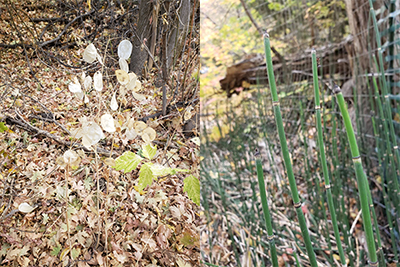
Money Plant, Lunaria Annua Horsetail, Equisetum arvense
Stop Four – Bridge
Topic: Watershed
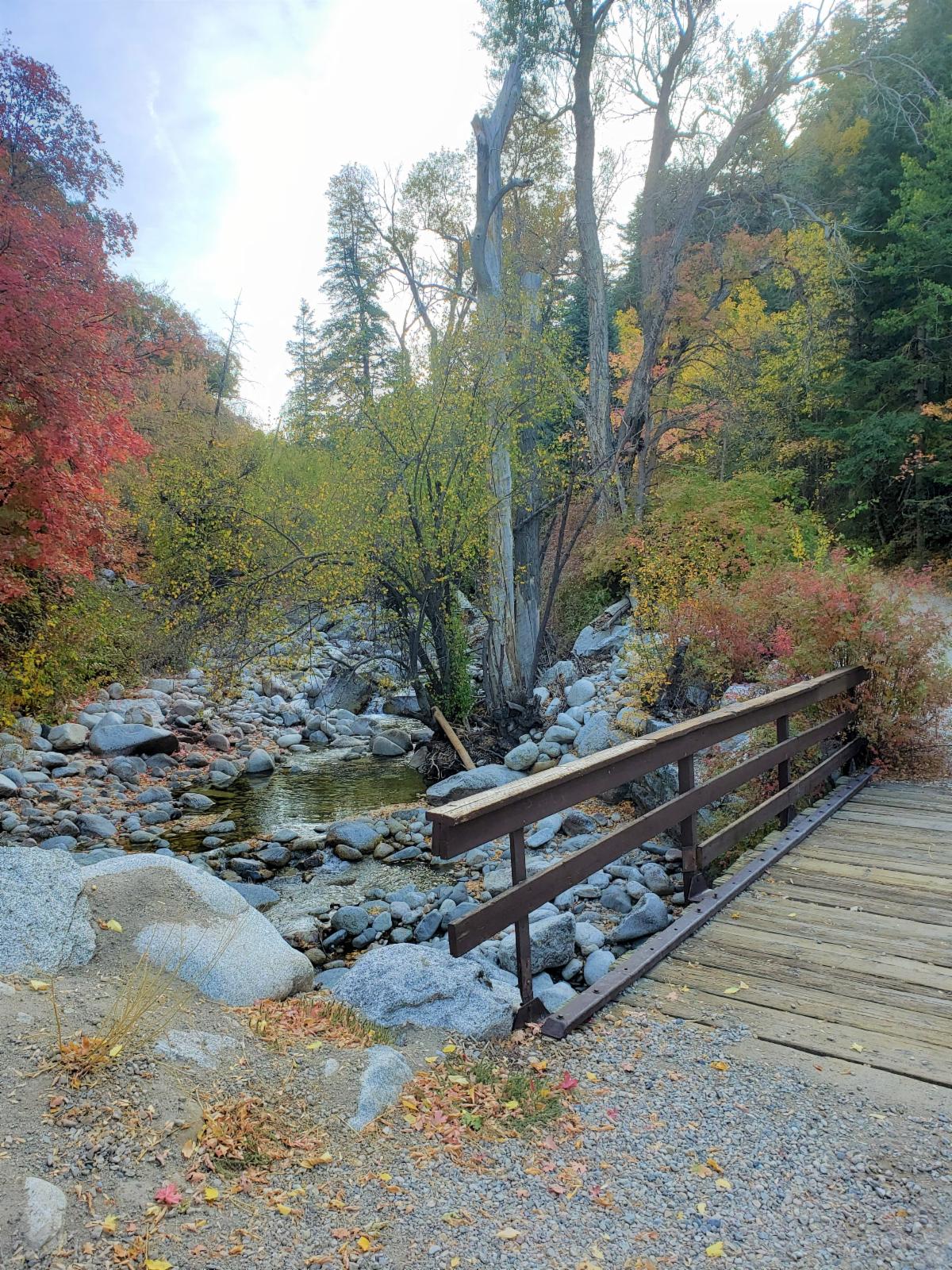 The watershed supports biodiversity in the canyons by providing water to all the living things! Fish and benthic macroinvertebrates spend their lives living in it. Amphibians (frogs, toads, and salamanders) lay their eggs and spend the first stages of their lifecycles in it. Mallard ducks swim in it. Terrestrial (land-dwelling) mammals use it to drink. Aquatic plants live their life underwater, while plants on land access groundwater and seeps. The watershed also provides diverse habitats, from swift running water to calmer wetlands and stagnant pools.
The watershed supports biodiversity in the canyons by providing water to all the living things! Fish and benthic macroinvertebrates spend their lives living in it. Amphibians (frogs, toads, and salamanders) lay their eggs and spend the first stages of their lifecycles in it. Mallard ducks swim in it. Terrestrial (land-dwelling) mammals use it to drink. Aquatic plants live their life underwater, while plants on land access groundwater and seeps. The watershed also provides diverse habitats, from swift running water to calmer wetlands and stagnant pools.
Biodiversity and watersheds go hand in hand. While the watershed supports the variety of life in the area, the biodiversity of the watershed itself can tell us how healthy the water is. In “Ecology on the Trail: Biodiversity”, we talked about the benthic macroinvertebrates (the bugs!) that live in the water. If you tried out the Water Quality module, you would have learned which bugs can only live in healthy water and which ones can live even where water is polluted. While the presence of those “pollution intolerant” bugs let us know that there was little pollution in our water sample, the other important factor is the diversity of the bugs that we see. Seeing a larger variety of species indicates healthier water than a water sample with only a few species.
Stop Five – Restoration Site
Topic: History and Human Use
A few years ago, what you would have seen here was a pavilion covered with graffiti. After it was demolished, a partnership with the U.S. Forest Service and the National Forest Foundation allowed us to replant this area in an effort to help return it to a natural state. To promote biodiversity, we planted a wide variety of flowers and shrubs including showy goldeneye, white sage, native raspberry, woodland rose and many more native species. 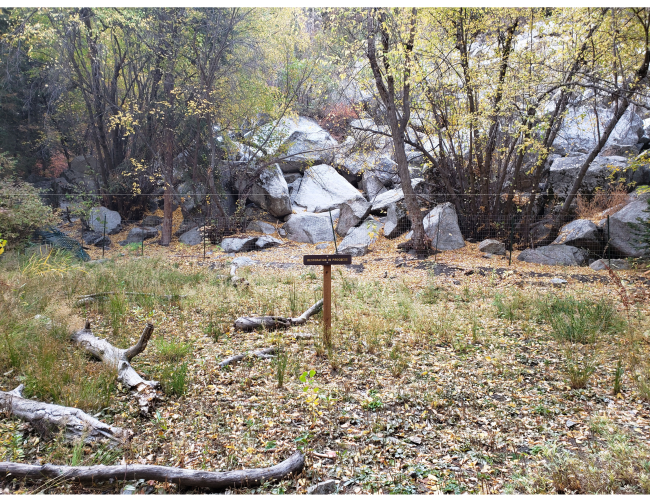 Planting helps to restore the soil, which had been heavily compacted from years of being under a large concrete structure. By planting native species, it also reduces the risk of the site being overtaken by invasive plants. Aside from what we have planted, some plants have naturally spread into the area. We’ve also seen a variety of pollinators (butterflies, bees, etc.), squirrels, and even snakes taking advantage of the revegetated area. Over the course of 3 summers, we planted close to 2,000 individual seedlings! Restoration is a process that can take a long time, and now we will let nature continue to do its work. We hope that this site will flourish and look even better in years to come!
Planting helps to restore the soil, which had been heavily compacted from years of being under a large concrete structure. By planting native species, it also reduces the risk of the site being overtaken by invasive plants. Aside from what we have planted, some plants have naturally spread into the area. We’ve also seen a variety of pollinators (butterflies, bees, etc.), squirrels, and even snakes taking advantage of the revegetated area. Over the course of 3 summers, we planted close to 2,000 individual seedlings! Restoration is a process that can take a long time, and now we will let nature continue to do its work. We hope that this site will flourish and look even better in years to come!
In these articles, we’ve talked about the ways that people have used the natural resources in the canyons and how the water we see here is our drinking water. The power of running water has also been used for something else: generating electricity. If you continue along the trail you’ll run into the remains of an old power plant. The Columbus Consolidated Mining Company built this station in 1903 in order to generate electricity to power mining operations up at Alta. Even today, Murray City operates a hydroelectric power plant here in Little Cottonwood Canyon. In fact, you walked right past it while hiking today!
Energy, like electricity, can be generated from renewable and nonrenewable sources. A renewable source has an unlimited supply and can be replenished naturally, like the sun or wind. A nonrenewable source exists in limited supplies and can take a very long time to replenish, like fossil fuels (coal, oil, and natural gas). Do you think that water is a renewable or nonrenewable source? Do you think it could be helpful to generate energy from diverse sources?
Bonus Activity
Bonus Activity: Bring the same tool (hula hoop, string, phone cord) you used to make a circle and find a spot along the trail to do another biodiversity study. Please keep your feet on the trail while you are investigating. How does what you found here compare with what you found at your home or school? What can you tell about the biodiversity at each location?
Post Activity
Let’s reflect on our experiences. What was your favorite thing that you learned? What was your favorite thing that you saw? How does being in nature make you feel?
